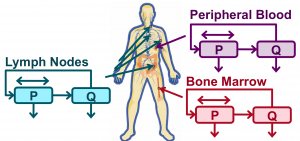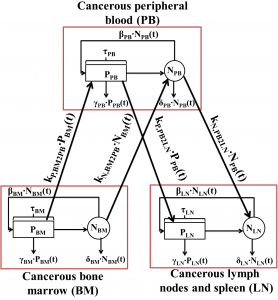Lead: Dr Symeon Savvopoulos

Delay differential equations represent the proliferating & non-pro-liferating cells in the lymph node, bone marrow, & peripheral blood.
Chronic Lymphocytic Leukemia (CLL) is the most common peripheral blood and bone marrow cancer in the developed world. This project proposes mathematical model equations representing the disease dynamics of B-cell CLL. We interconnect delay differential cell cycle models in each of the tumour-involved disease centres using physiologically-relevant cell migration. We further introduce 5 hypothetical case studies representing CLL heterogeneity commonly seen in clinical practice and demonstrate how the proposed CLL model framework may capture disease pathophysiology across patient types. We explore the capacity of the proposed temporally- and spatially-distributed model to capture the heterogeneity of CLL disease progression. By using Global Sensitivity Analysis, the critical parameters influencing disease trajectory over space and time are: (i) the initial number of CLL cells in peripheral blood, the number of involved lymph nodes, the presence and degree of splenomegaly; (ii) the migratory fraction of non-proliferating as well as proliferating CLL cells from bone marrow into blood and of proliferating CLL cells from blood into lymph nodes; (iii) the parameters inducing non-proliferative cells to proliferate. The proposed model offers a practical platform which may be explored in future personalised patient protocols once validated.

B-CLL modelling framework incorporates the major disease compartments
Collaborators
- Dr Nicki Panoskaltsis (Hematology, Joint Supervision)
- Prof Sakis Mantalaris (Bioprocess Engineering)
- Prof Stratos Pistikopoulos (Mathematical Modeling)

